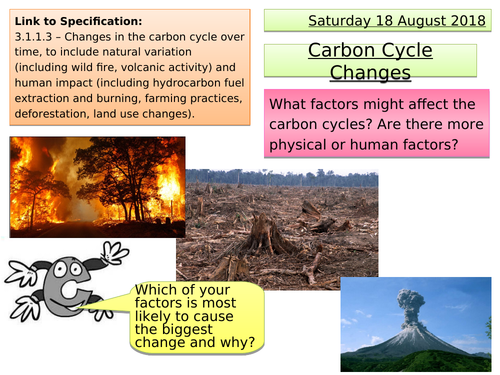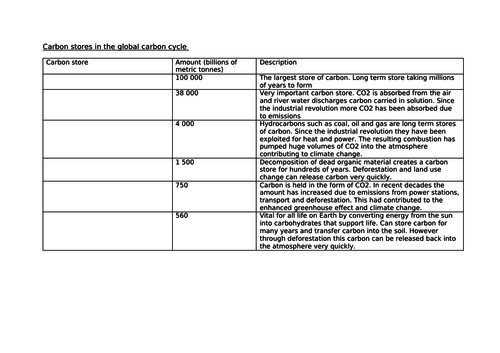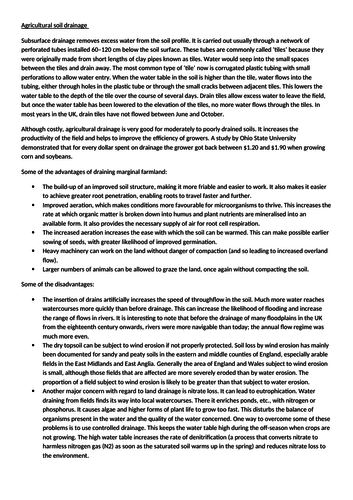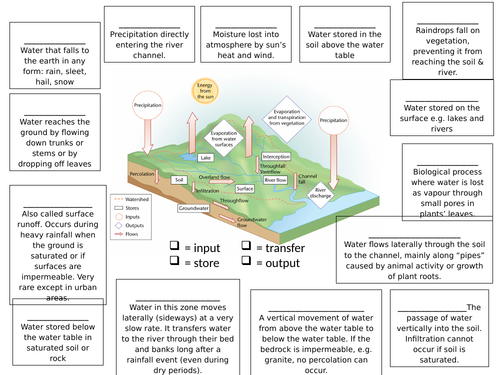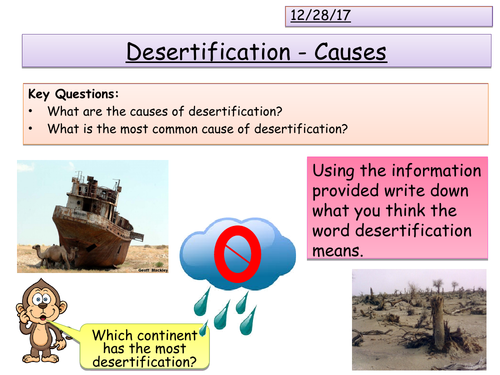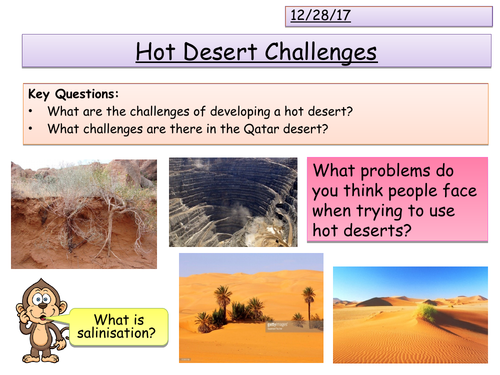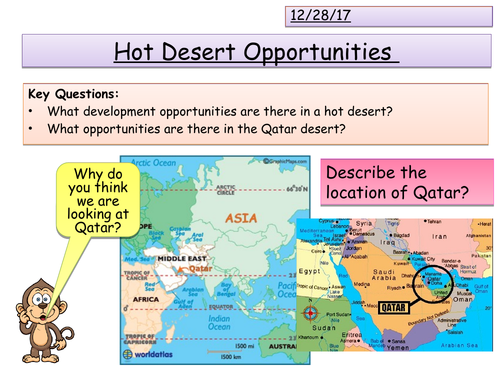
156Uploads
227k+Views
288k+Downloads
All resources

Fragile Extreme Environments
A lesson designed for KS3 Geography. This is lesson 5 from a unit titled Extreme Environments.
This lesson will allow students to answer the following key questions:
• Why are extreme environments fragile?

Animal and Plant Adaptation
A lesson designed for KS3 Geography. This is lesson 4 from a unit titled Extreme Environments.
This lesson will allow students to answer the following key questions:
• How do plants and animals adapt to survive in Hot Arid regions?

Hot Arid Regions
A lesson designed for KS3 Geography. This is lesson 3 from a unit titled Extreme Environments.
This lesson will allow students to answer the following key questions:
• What are the characteristics of hot arid regions?
• How is global warming impacting hot arid regions?

Polar Regions
A lesson designed for KS3 Geography. This is lesson 2 from a unit titled Extreme Environments.
This lesson will allow students to answer the following key questions:
What are the characteristics of Polar regions?
How is global warming impacting polar regions?

What are Extreme Environments
A lesson designed for KS3 Geography. This is lesson 1 from a unit titled Extreme Environments.
This lesson will allow students to answer the following key questions:
What are the characteristics of Polar and Hot Arid regions?
What are the main causes of extreme environments?

Contemporary Urban Environments - AQA A Level
This resources contains all lessons for the AQA A Level unit of Contemporary Urban Environments. All resources are provided except for a geofile on air pollution in Beijing.
Pages referenced are for the Human Geography Book created by Oxford University Press.
Bundle

Water and Carbon Cycles
All lessons and resources needed to teach the Water and Carbon Cycle unit. The only element missing is the 2 case studies.

Carbon Budget - AQA A Level
This lesson is based around the new AQA A Level specification. This is a lesson in the unit titled Water and Carbon Cycles. The main aim of this lesson is to cover the following element of the specification:
3.1.1.3 – The carbon budget and the impact of the carbon cycle upon land, ocean and atmosphere, including global climate.
Any pages referenced are from the Oxford physical textbook.
Please note I do not own the rights to any of the images used in this powerpoint.

Carbon Cycle Changes - AQA A Level
This lesson is based around the new AQA A Level specification. This is a lesson in the unit titled Water and Carbon Cycles. The main aim of this lesson is to cover the following element of the specification:
3.1.1.3 – Changes in the carbon cycle over time, to include natural variation (including wild fire, volcanic activity) and human impact (including hydrocarbon fuel extraction and burning, farming practices, deforestation, land use changes).
Any pages referenced are from the Oxford physical textbook.
Please note I do not own the rights to any of the images used in this powerpoint.

The Carbon Cycle - AQA A Level
This lesson is based around the new AQA A Level specification. This is a lesson in the unit titled Water and Carbon Cycles. The main aim of this lesson is to cover the following element of the specification:
3.1.1.3 – Global distribution, and size of major stores of carbon – lithosphere, hydrosphere, cryosphere, biosphere, atmosphere.
Factors driving change in the magnitude of these stores over time and space, including flows and transfers at plant, sere and continental scales. Photosynthesis, respiration, decomposition, combustion, carbon sequestration in oceans and sediments, weathering.
Any pages referenced are from the Oxford physical textbook.
Please note I do not own the rights to any of the images used in this powerpoint.

Water Cycle Changes - AQA A Level
This lesson is based around the new AQA A Level specification. This is a lesson in the unit titled Water and Carbon Cycles. The main aim of this lesson is to cover the following element of the specification:
3.1.1.2 – Changes in the water cycle over time to include natural variation including storm events, seasonal changes and human impact including farming practices, land use change and water abstraction.
Any pages referenced are from the Oxford physical textbook.
Please note I do not own the rights to any of the images used in this powerpoint.

Hydrographs - AQA A Level
This lesson is based around the new AQA A Level specification. This is a lesson in the unit titled Water and Carbon Cycles. The main aim of this lesson is to cover the following element of the specification:
3.1.1.2 – The water cycle
Runoff variation and the flood hydrograph.
Any pages referenced are from the Oxford physical textbook.
Please note I do not own the rights to any of the images used in this powerpoint.

Drainage Basin - AQA A Level
This lesson is based around the new AQA A Level specification. This is a lesson in the unit titled Water and Carbon Cycles. The main aim of this lesson is to cover the following element of the specification:
3.1.1.2 – The water cycle
Drainage basins as open systems – inputs and outputs, to include precipitation, evapotranspiration and runoff; stores and flows, to include interception, surface, soil water, groundwater and channel storage; stemflow, infiltration overland flow, and channel flow. Concept of water balance.
Any pages referenced are from the Oxford physical textbook.
Please note I do not own the rights to any of the images used in this powerpoint.

A Systems Approach - AQA A Level
This lesson is based around the new AQA A Level specification. This is a lesson in the unit titled Water and Carbon Cycles. The main aim of this lesson is to cover the following element of the specification:
3.1.1.1 – Water and carbon cycles as natural systems.
Systems in physical geography: systems concept and their application to the water and carbon cycle inputs – outputs, energy, stores/components, flows/transfers, positive/negative feedback, dynamic equilibrium
Any pages referenced are from the Oxford physical textbook.
Please note I do not own the rights to any of the images used in this powerpoint.
Bundle

Living World
This bundle contains all lesson required to teach the Whole of the Living World Unit, which is part of the new AQA GCSE Specification. This contains the compulsory element of Tropical Rainforests and the optional unit of Hot Deserts.
I have included the deforestation lesson of the unit for free so that you can get a feel for the style of lessons.

Managing Desertification
This lesson is based around the new AQA GCSE specification. This is a lesson in the unit titled Living World. The main aim of this lesson is to cover the following element of the specification:
- Strategies used to reduce the risk of desertification – water and soil management, tree planting and use of appropriate technology.
NOTE - When it refers to page numbers please refer to the information provided.

Causes of Desertification
This lesson is based around the new AQA GCSE specification. This is a lesson in the unit titled Living World. The main aim of this lesson is to cover the following element of the specification:
- Causes of desertification – climate change, population growth, removal of fuel wood, overgrazing, over-cultivation and soil erosion.
NOTE - When it refers to page numbers please refer to the information provided.

Challenges of Deserts - Qatar
This lesson is based around the new AQA GCSE specification. This is a lesson in the unit titled Living World. The main aim of this lesson is to cover the following element of the specification:
A case study of a hot desert to illustrate:
- Challenges of developing hot desert environments: extreme temperatures, water supply, inaccessibility.
NOTE - When it refers to page numbers please refer to the information provided.

Desert Opportunities - Qatar
This lesson is based around the new AQA GCSE specification. This is a lesson in the unit titled Living World. The main aim of this lesson is to cover the following element of the specification:
A case study of a hot desert to illustrate:
- Development opportunities in hot desert environments: mineral extraction, energy, farming, tourism
NOTE - When it refers to page numbers please refer to the information provided.

Hot Desert Characteristics
This lesson is based around the new AQA GCSE specification. This is a lesson in the unit titled Living World. The main aim of this lesson is to cover the following element of the specification:
- The physical characteristics of a hot desert.
- The interdependence of climate, water, soils, plants, animals and people.
- How plants and animals adapt to the physical conditions.
- Issues related to biodiversity
NOTE - When it refers to page numbers please refer to the information provided.









